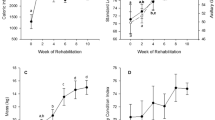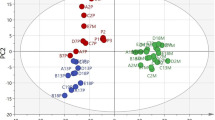Abstract
In this study we measure energy intake via milk in nursing bearded seal (Erignathus barbatus) pups and determine how this energy is allocated into metabolism and storage of new tissues. This was accomplished using longitudinal mass gain records and the doubly labelled water technique on nursing pups in combination with cross-sectional data on changes in milk composition from bearded seal mothers. The pups (n=3) were all less than a week old at the start of the experiments. Pups gained 3.3±0.4 kg·day-1 of which 50% was fat, 14% protein and 36% water. Average daily water influx for the pups was 69.5±9.0 ml · kg-1· day-1. Average CO2 production during the study period was 0.99±0.10 ml·g-1·h-1, which corresponds to a field metabolic rate of 642±67 kJ·kg-1· day-1, or 6.0±0.5 times the predicted basal metabolic rate according to Kleiber (1975). The pups drank an average of 7.6±0.5 kg of milk daily. This corresponds to a daily energy intake of 154±8 MJ, 47±14% of which was stored as new body tissue. Despite this high energy intake bearded seal pups do not get as fat as do other nursing phocids. This is in part due to their larger body size but also due to their very active aquatic lifestyle and the lower and more consistent fat content of the milk compared to other phocid species. Bearded seal mothers forage during lactation and may also be involved in teaching their pups to feed independently. All these data suggest that the lactation strategy of bearded seals differs from the phocid norm.
Similar content being viewed by others
Abbreviations
- BM :
-
body mass
- BMR :
-
basal metabolic rate
- FMR :
-
field metabolic rate
- HT 18 :
-
O doubly labelled water
- HTO :
-
tritiated water
- IU :
-
international unit
- RQ :
-
respiration quotient
- TBW :
-
total body water
- TDR :
-
time-depth recorder
- VHF :
-
very high frequency
References
AOAC (1990) Official methods for analysis of the Association of Official Analytical Chemists Inc, 15th edn. Helrich K (ed) AOAC, Arlington, Virginia, USA
Bowen WD, Oftedal OT, Boness DJ (1985) Birth to weaning in 4 days: remarkable growth in the hooded seal,Cystophora cristata. Can J Zool 63: 2841–2846
Bowen WD, Oftedal OT, Boness DJ (1992) Mass and energy transfer during lactation in a small phocid, the harbor scal (Phoca vitulina). Physiol Zool 65: 844–866
Burns JJ (1967) The Pacific bearded seal. Alaska Dept Fish and Game, Juneau, Alaska, USA
Burns JJ (1981) Bearded sealErignathus barbatus Erxleben, 1777. In: Ridgway SH, Harrison RJ (eds) Handbook of marine mammals, vol 2. Seals. Academic Press, London, pp 145–170
Carlini AR, Marques MEI, Soave G, Vergani DF, Ronayne de Ferrer PA (1994) Southern elephant seal,Mirounga leonina: composition of milk during lactation. Polar Biol 14: 37–42
Chapskii KK (1938) The bearded seal (Erignathus barbatus, Fabr.) of the Kara and Barents Seas. Can Fish Mar Serv Transl Ser No 3162
Costa DP (1987) Isotopic methods for quantifying material and energy intake in free-ranging marine mammals. In: Huntley AC et al. (eds) Approaches to marine mammal energetics. Allen Press, Lawrence, Kansas, pp 43–66
Degerbøl M, Freuchen P (1935) Zoology I. Mammals. Rep 5th Thule Exped 1921–24. Gyldendalske Boghandel, Nordisk Forlag, Copenhagen
Depocas F, Hart JS, Fisher HD (1971) Sea water drinking and water flux in starved and in fed harbor seals,Phoca vitulina. Can J Physiol Pharmacol 49: 53–62
Hammill MO, Kovacs KM, Lydersen C (1994) Local movements by nursing bearded seal (Erignathus barbatus) pups in Kongsfjorden, Svalbard. Polar Biol 14: 569–570
Hammill MO, Lydersen C, Ryg M, Smith TG (1991) Lactation in the ringed seal (Phoca hispida). Can J Fish Aquat Sci 48: 2471–2476
Hammill MO, Smith TG (1991) The role of predation in the ecology of the ringed seals in Barrow Strait, Northwest Territories, Canada. Mar Mammal Sci 7: 123–135
Iverson SJ, Bowen WD, Boness DJ, Oftedal OT (1993) The effect of maternal size and milk energy output on pup growth in grey seals (Halichoerus grypus). Physiol Zool 66: 61–88
Kleiber M (1975) The fire of life: an introduction to animal energetics. Krieger, Huntington, New York
Kooyman GL, Drabek CM (1968) Observations on milk, blood, and urine constituents of the Weddell seal. Physiol Zool 41: 187–194
Kovacs KM (1987a) Maternal behaviour and early behavioural ontogeny of harp seals,Phoca groenlandica. Anim Behav 35: 844–855
Kovacs KM (1987b) Maternal behaviour and early behavioural ontogeny of grey seals (Halichoerus grypus) on the Isle of May, UK. J Zool (Lond) 213: 697–715
Kovacs KM, Lavigne DM (1985) Neonatal growth and organ allometry of northwest Atlantic harp seals (Phoca groenlandica). Can J Zool 63: 2793–2799
Kovacs KM, Lavigne DM (1986) Maternal investment and neonatal growth in phocid seals. J Anim Ecol 55: 1035–1051
Kretzmann MB, Costa DP, LeBoeuf BJ (1993) Maternal energy investment in elephant seal pups: evidence for sexual equality? Am Nat 141: 466–480
Lawson JW, Renouf D (1985) Parturition in the Atlantic harbor seal,Phoca vitulina concolor. J Mammal 66: 395–398
Lydersen C (1995) Energetics of pregnancy, lactation and neonatal development in ringed seals (Phoca hispida). In: Blix AS et al. (eds) Whales, seals, fish and man. Elsevier, Amsterdam, pp 319–327
Lydersen C, Hammill MO (1993a) Diving in ringed seal (Phoca hispida) pups during the nursing period. Can J Zool 71: 991–996
Lydersen C, Hammill MO (1993b) Activity, milk intake and energy consumption in free-living ringed seal (Phoca hispida) pups. J Comp Physiol B 163: 433–438
Lydersen C, Kovacs KM (1996) Energetics of lactation in harp seals (Phoca groenlandica) from the Gulf of St. Lawrence, Canada. J Comp Physiol B 116: 295–304
Lydersen C, Hammill MO, Kovacs KM (1994) Diving activity in nursing bearded seal (Erignathus barbatus) pups. Can J Zool 72: 96–103
Lydersen C, Hammill MO, Kovacs KM (1995) Milk intake, growth and energy consumption in pups of ice-breeding grey seals (Halichoerus grypus) from the Gulf of St. Lawrence, Canada. J Comp Physiol B 164: 585–592
Lydersen C, Hammill MO, Ryg MS (1992) Water flux and mass gain during lactation in free-living ringed seal (Phoca hispida) pups. J Zool (London) 228: 361–369
McLaren IA (1958a) Some aspects of growth and reproduction of the bearded seal,Erignathus barbatus (Erxleben). J Fish Res Bd Can 15: 219–227
McLaren IA (1958b) The biology of the ringed seal (Phoca hispida Schreber) in the eastern Canadian arctic. Bull Fish Res Bd Can 11
Nagy KA (1980) CO2 production in animals: analysis of potential errors in the doubly labeled water method. Am J Physiol 238: R466-R473
Nagy KA, Costa DP (1980) Water flux in animals: analysis of potential errors in the tritiated water method. Am J Physiol 238: R454-R465
Oftedal OT, Bowen WD, Boness DJ (1993) Energy transfer by lactating hooded seals and nutrient deposition in their pups during the four days from birth to weaning. Physiol Zool 66: 412–436
Oftedal OT, Bowen WD, Boness DJ (1996) Lactation performance and nutrient deposition in pups of the harp scal,Phoca groenlandica, on ice floes off Southeast Labrador. Physiol Zool 69: 635–657
Reilly JJ (1989) The energetics of lactation in grey scals (Halichoerus grypus) (Abstract). 8th Bien Conf Biol Mar Mamm, Pacific Grove, California, USA
Reilly JJ, Fedak MA (1990) Measurement of body composition of live gray seals by hydrogen isotope dilution. J Appl Physiol 69: 885–891
Renouf D, Noseworthy E, Scott MC (1990) Daily fresh water consumption by captive harp seals (Phoca groenlandica). Mar Mammal Sci 6: 253–257
Riedman M, Ortiz CL (1979) Changes in milk composition during lactation in the northern elephant seal. Physiol Zool 52: 240–249
Römer F, Schaudinn F (1900) Plan des Werkes und Reisebericht. II. Die Landtiere und die Eistiere. Fauna Arctica 1: 1–84
Smith TG, Stirling I (1975) The breeding habitat of the ringed seal (Phoca hispida). The birth lair and associated structures. Can J Zool 53: 1297–1305
Tedman R, Green B (1987) Water and sodium fluxes and lactational energetics in suckling pups of Weddell seals (Leptonychotes weddellii) J Zool (London) 212: 29–42
Author information
Authors and Affiliations
Additional information
Communicated by H. Langer
Rights and permissions
About this article
Cite this article
Lydersen, C., Kovacs, K.M., Hammill, M.O. et al. Energy intake and utilisation by nursing bearded seal (Erignathus barbatus) pups from Svalbard, Norway. J Comp Physiol B 166, 405–411 (1996). https://doi.org/10.1007/BF02337884
Accepted:
Issue Date:
DOI: https://doi.org/10.1007/BF02337884




